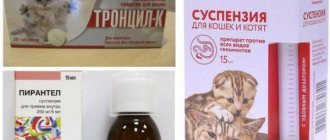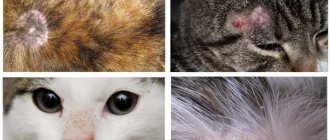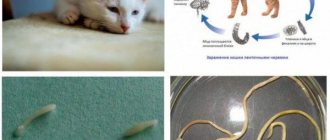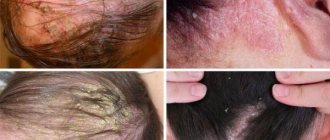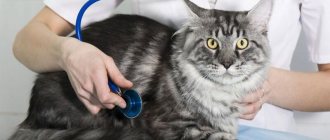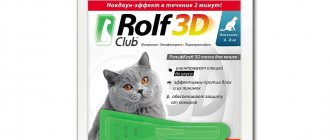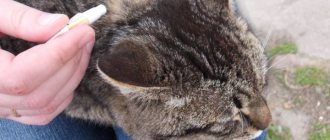Sometimes, even after flea treatment, the cat continues to itch. Itching can be caused by drugs of dubious quality, allergic reactions, or scratching on the body. Only a veterinarian can accurately determine the causes and prescribe proper treatment.
Let's find out what additional symptoms will help in making a diagnosis and how to help the cat before the doctor arrives.
Causes of itching in dogs and cats
The unpleasant, irritating sensation of itching is familiar not only to people, but also to our smaller brothers. Experiencing itchy skin, pets begin to frantically scratch, lick and bite their fur. Many owners associate their restless behavior with flea infestation. After all, parasites bite through the animal’s skin and suck its blood, thereby causing severe itching.
But not everything is as simple as it might seem at first glance. Itchy skin can be caused by other parasites, fungal or bacterial infections, or allergies.
Parasitic causes of itching
If a dog or cat is itching, but there are no fleas, then the main cause of itchy skin is infection with parasites. Most often pets suffer from:
- pruritic (scabies) mites, which cause the development of sarcoptic mange - a skin disease;
- ear mites, infection with which leads to the development of otodectosis - very painful ear scabies;
- lice-eaters, which look like lice and cause the development of trichodectosis - a skin disease.
It is important to know! Regular antiparasitic treatment helps prevent infection. To carry it out, it is better to choose complex-action drugs that effectively destroy all dangerous parasites - fleas, ticks, lice eaters, etc. Drops on the withers cope well with this task. Such drugs include Stronghold drops.
Fungal and bacterial infections
When answering the question why a dog or cat itches if there are no fleas, it is worth suspecting another common cause of itching - fungal and bacterial skin lesions. They often develop as a result of the progression of parasitic diseases. After all, scabies, ear mites and lice mites cause severe itching. This means that the dog or cat itches until it hurts and injures its skin. As a result of constant scratching, the protective functions of the skin are reduced and a favorable environment is created on its surface for the active activity of pathogenic fungi and bacteria. Most often we are talking about such lesions as:
- lichen is a contagious fungal disease that can be transmitted from a sick animal to humans;
- pyoderma is a bacterial disease of the hair follicles and the top layer of the pet’s skin.
It is important to know! Various kinds of microorganisms are permanent inhabitants of the skin of animals. They are not dangerous for pets with high immunity and healthy skin. Hygiene measures and comprehensive antiparasitic treatment help maintain this balance. But if an adult animal, kitten or puppy is still constantly itching, and there are no fleas or other parasites, then most likely we are talking about an allergy.
Causes of allergic itching
Allergies are another reason why a cat or dog is itchy, but there are no fleas. Its development is associated with the increased sensitivity of the animal’s body to various kinds of substances (allergens) - plant pollen, house dust, household chemicals, etc. Often allergic itching of the skin is caused by a negative reaction of the pet’s body to insect bites (most often fleas), and sometimes for food. Constant contact with allergens leads to the development of chronic dermatitis.
It is important to know! If there are no fleas, but the cat or dog is itching, then you need to determine the causes of the skin itching as quickly as possible. To do this, you need to seek help from a veterinarian. You should not self-medicate, relying on “miraculous” methods of traditional medicine or advice from “knowledgeable” people.
There are no fleas, but the cat still continues to itch
It seems that it is enough to treat the animal, apply anti-parasite drops, and your furry friend should immediately stop experiencing discomfort and itching. But in practice, the cat continues to vigorously scratch its neck even in the absence of bloodsuckers.
What causes itching in cats:
- Sarcoptic mange or scabies mite is localized on the ankles, elbows, and behind the ears. The diagnosis is announced by a veterinarian after taking a skin scraping for analysis.
- Allergies may occur to new cat food. The animal scratches its ears, muzzle, and paws. Antihistamines and a hypoallergenic diet are prescribed. Also, when a flea bites, they secrete a secretion to which animals are often allergic. If a kitten goes outside for a walk for the first time, and after an hour he starts scratching his stomach and chest, his skin turns red - he is allergic to plant pollen.
- Pathogenic bacteria and fungi found on a healthy animal do not cause it any harm. But as soon as the protective functions are weakened due to a lack of vitamins, diseases, flea products, bacteria begin to actively multiply, worsening the condition of the skin and the health of the pet.
- Otitis media becomes a source of severe pain and itching, the pet shakes its head, scratches its ears, neck, and muzzle. Upon examination, you can see a black, dirty coating in the ear, redness, and smell an unpleasant odor.
- Skin diseases, these include pyodermatitis, demodicosis, cheyletiellosis and notoedrosis. Only a veterinarian can make a diagnosis, suggesting how to treat the skin and cure the animal.
Professional diagnosis of itchy skin
Skin itching is a clinical sign not only of diseases, but also of specific conditions of the pet’s body. Especially if the cat or dog is itching, but there are no fleas and the skin is clean. In this case, the appearance of itching may be associated with stress, mental disorders, nervous or hormonal disorders, peculiarities of keratinization of the epidermis (upper layer of skin) or other reasons. Therefore, the veterinarian is faced with a difficult task - the specialist will have to find out why a dog or cat is itching if it does not have fleas and prescribe adequate treatment for the pet. To solve it, a comprehensive diagnosis is used, each stage of which helps to establish the true cause of itching.
- First, skin scrapings are taken from the pet to identify mites and a trial antiparasitic treatment is prescribed.
- Then a cytological examination and (or) bacteriological culture is performed, which helps to identify fungal and bacterial infections.
- Dietary nutrition is prescribed to exclude food allergies, etc.
If a dog or cat is itching, but there are no fleas, then the veterinarian must study the pet’s medical history - the presence of hereditary diseases, living conditions, hygiene features, the influence of traumatic and other factors. And if a puppy or kitten itches, but there are no fleas, then not only the baby’s body, but also the medical history of its parents must be examined.
Precautionary measures
- Although celandine drops are not overly toxic, it is still poison, so the following safety precautions must be observed when using the drug.
- The person performing the procedure on the cat must wear special gloves that protect the skin of their hands.
- Avoid contact of the drug with the eyes or any other mucous membranes of both yourself and your pet.
- To protect yourself from celandine entering the body, you should not eat, smoke or drink during the procedure.
- If the drug is ingested, gastric lavage should be performed.
- After the procedure, it is enough to wash your hands with soap or disinfect them.
- An empty container of celandine must be disposed of.
Treatment of itching in dogs and cats
The dog or cat is itching, there are no fleas, what to do in such a situation? The answer to this question is simple - the pet is given treatment aimed at eliminating the causes of itching.
- When infected with ticks, antiparasitic treatment is carried out.
- For fungal or bacterial infections, local and systemic agents are used to destroy the infection.
- For allergic itching, medications that control itching are prescribed, such as Apoquel tablets, a therapeutic diet, etc.
If there are no fleas and we are talking about parasites that cause the kitten or puppy to itch, then treatment is carried out not only for the baby, but also for his parents. During treatment of the disease, while the dog or cat is constantly licking and itching strongly, to alleviate its condition, the veterinarian may prescribe medications that relieve itching, the use of special shampoos, and other means.
Overdose
In the pets of overly diligent owners, flea collars often cause poisoning rather than allergies. Why is this happening? It is recommended to put the collar on a clean, flea-free animal.
Therefore, the owner carries out preliminary anti-flea treatment of the pet and its habitat, also using toxic substances. If you put on a collar immediately after treatment, the amount of toxins on the animal will exceed the permissible limit.
After the withers and sprays, you can put the collar on no earlier than 7-10 days. A collar may be completely unnecessary, since the protective effect of the drops lasts 1-2 months.
The immune system of our pets is structured almost the same as our human one. When any allergen enters a cat’s body, the immune system begins to fight it, but unfortunately, it is not always effective.
In this case, the animal begins to have an allergic reaction and it is our direct responsibility to recognize this in time and take action, because cats suffer allergies much more severely than people.
Prevention of itchy skin
Based on the reasons described above, the most effective prevention of itchy skin is regular antiparasitic treatment of your pet. It must be carried out even if the dog or cat is itching and licking, but there are no fleas. Moreover, regardless of whether the animal has access to the street. After all, scabies, ear mites, lice mites and other parasites are ubiquitous - they enter our home on the owner’s shoes and clothes, and household items. At the same time, fleas and other parasites are not always visible on an animal with the naked eye. And there may be a misconception that the itching is not due to parasites.
To simplify antiparasitic treatment for the owner and pet as much as possible, it is better to choose a one-time use drug - so that the product is applied to the skin just once, and it reliably protects the pet from all parasites for a long time. To achieve this effect, you can use Stronghold. – drops on the withers for dogs and cats. The drug is suitable not only for adult animals, but also for puppies, kittens over 6 weeks old, as well as pregnant and lactating animals.
Of no small importance in the prevention of skin itching is hygiene, diet and conditions for keeping a pet, including the psychological atmosphere in the house. Also, you should not ignore the obsessive behavior of your pet - when a dog or cat constantly licks and scratches, but there are no fleas.
Flea dermatitis
The main cause of itching in cats is fleas. The fact that parasites are not visible does not mean that they do not exist. It is especially difficult to detect pests in long-haired breeds with a thick undercoat. Even the most careful care of your pet does not guarantee protection from this nuisance, and anti-flea treatment of the animal at home does not always help to cope with insects the first time.
The lack of effect from the use of antiparasitic drops may be explained by:
- low quality of the drug in case of purchasing counterfeit products;
- expired medicinal product;
- failure to follow the instructions for using the flea insecticide.
To avoid purchasing low-quality products, you should purchase drops only from veterinary clinics and pet stores with permission to sell veterinary drugs. At the same time, sellers are obliged to provide, at the client’s request, all necessary documents confirming the quality of the goods. If you follow the manufacturer's recommendations, reliable, high-quality and proven brands will rid your pet of pests within a matter of hours after use. Additional protection will be provided by treating carpets, beds and the animal’s favorite resting places.
Since repeated application of the drug can cause intoxication of the kitten’s body, the decision to use a different insecticide should be made after consultation with a veterinarian.
Dangerous symptoms: what to look out for?
By nature, pets are quite clean. Especially cats, which can groom their fur up to 10 times a day or more. It seems to us that the cat is constantly licking itself, although there are no fleas, but in fact it is performing a hygienic ritual laid down by nature.
Also, do not forget that the hair of dogs and cats is subject to natural shedding. Moreover, it does not happen twice a year, but almost constantly. It’s just that in spring and autumn the pet sheds more intensely, and we notice this process - the cat, dog itches and hair falls out, although there are no fleas. Active hair loss is also observed when the coat changes in young animals and after the end of lactation in adults.
The shedding process causes particular problems for long-haired pets and those with thick hair. In the absence of adequate care (combing) during this period, the animal’s fur can fall off, curl into cords, and form tangles, which causes discomfort to the animal. While experiencing it, the dog or cat also itches.
Simple observation of the pet, as well as a careful examination of it, will help to distinguish natural processes from the symptoms of the disease. You should pay attention to the presence of such dangerous signs as:
- redness;
- swelling;
- wounds, scratches, deep scratches, scabs;
- pimples, rashes, blisters, pustules;
- unpleasant odor;
- brown discharge from the ear;
- hairless areas of skin;
- profuse dandruff, etc.
You should be concerned if a dog or cat itches, licks, bites itself, rubs against furniture and rolls on the floor. And also if the pet suddenly becomes lethargic, refuses to eat, drinks a lot, sleeps poorly, whines or meows pitifully. All these signs may indicate the development of a pathological process. Therefore, without wasting time, you need to make an appointment with a veterinarian. Describe your problem to him in detail and a specialist will find out why this is happening.
At what age are flea drops used?
Almost all drugs are intended for cats aged 2-3 months, but there are also safe drops that can be used for treatment earlier.
Some cat drops suitable for pregnant and lactating cats are contraindicated for kittens. Therefore, to avoid harming the animal, read the package insert.
Frequency of treatment of kittens
To prevent the appearance of fleas, prevention is required once a quarter. If a kitten is infested with fleas, it should be treated with antiparasitic medication immediately.
Effective drops work instantly, killing blood-sucking insects from the first minutes of contact with the pet’s body.
Rules for handling pets
Before using drops, you must read the instructions for their use. The instructions contain information about indications, contraindications and precautions.
Standard rules for handling domestic cats:
- When applying the medicine, do not allow it to come into contact with the skin.
- After treating the animal, even if the drug was in ampoules, wash your hands thoroughly.
- In order to achieve maximum effect and be able to quickly identify adverse reactions, the kitten should be supervised for the first 2-3 hours.
- If your pet must be left alone, put a veterinary cone on him.
Precautionary measures
The peak of toxicity, when the drops act, occurs on the first day. Therefore, it is forbidden to pet the animal and allow it near children.
If a treated cat accidentally comes into contact with human skin, rinse the area with plenty of water. Avoid contact with mucous membranes and affected areas of the skin.
